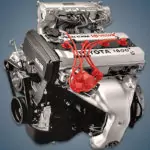The 2.0-liter Toyota 3S-GE engine was produced at the plant in Japan from 1984 to 2005 and was installed on sports versions of such popular models as Camry, Corona, Celica and Altezza. A huge number of versions of the motor are divided into 5 generations, the last two are called Beams.
One of the most famous Toyota engines of its time appeared in 1984. It was a classic multi injection engine with a 4-cylinder cast-iron block, but equipped with a sports 16-valve cylinder head developed by Yamaha engineers. Unlike other engines in the series, the timing belt rotates both camshafts here, and not just the intake. The unit received a huge number of advanced systems, we will discuss them in more detail below.
All countless versions of this power unit are conventionally divided into 5 generations:
- The 1st generation of such engines was called 3S-GELU and was produced from 1984 to 1989. The version for the American market with pistons for a compression ratio of 9.2 developed only 135 hp, and the Japanese version, thanks to the T-VIS system and the absence of an EGR valve, produced 160 hp.
- The 2nd generation was produced from 1989 to 1993 and could be distinguished by a different cover. The compression ratio in the engine was raised to 10 and the power increased to 155 and 165 hp, respectively. Also, the T-VIS variable intake system has given way here to the more efficient ACIS.
- The company produced the 3rd generation of power units or 3S-GE gen3 from 1993 to 1999. The compression ratio rose again to 10.3, the power of export engines increased to 170, Japanese to 180 hp.
- The 4th generation of 3S-GE Beams was divided into two versions, they differed in the color of the caps. The Gray Top modification was distinguished by a black and gray top and it developed power from 180 to 190 hp. The Red Top modification with a red valve cover was slightly more powerful: from 190 to 200 hp. Technically, these power units practically did not differ, the compression ratio grew to 11.1, for the first time in the series, a VVT-i type phase control system appeared on the intake camshaft.
- The 5th generation or Black Top was installed only on the Japanese Altezza model from 1997 to 2005. It was on this unit that the proprietary Dual VVT-i dual phase control system debuted. The version of this engine for an automatic transmission with a compression ratio of 11.1 developed 200 hp. The modification for the manual transmission had a compression ratio of 11.5 and developed about 210 hp.
The S family includes engines: 4S‑Fi, 4S‑FE, 3S‑FC, 3S‑FE, 3S‑FSE, 3S‑GE, 3S‑GTE, 5S‑FE.
The engine was installed on:
- Toyota Altezza 1 (XE10) in 1998 – 2005;
- Toyota Camry 1 (V10) in 1984 – 1986; Camry 2 (V20) in 1986 – 1992; Camry V30 in 1990 – 1994;
- Toyota Caldina 1 (T190) in 1992 – 1997; Caldina 2 (T210) in 1997 – 2002;
- Toyota Celica 4 (T160) in 1985 – 1989; Celica 5 (T180) in 1989 – 1993; Celica 6 (T200) in 1993 – 1999;
- Toyota Corona 8 (T150) in 1985 – 1987; Corona 9 (T170) in 1987 – 1992; Corona 10 (T190) in 1992 – 1996; Corona 11 (T210) in 1996 – 2001;
- Toyota Curren 1 (T200) in 1994 – 1998;
- Toyota MR2 2 (W20) in 1989 – 1999;
- Toyota RAV4 1 (XA10) in 1994 – 2003.
Specifications
| Production years | 1984-2005 |
| Displacement, cc | 1998 |
| Fuel system | injector |
| Power output, hp | 135 – 180 (1, 2, 3 gen.) 180 – 210 (4, 5 gen.) |
| Torque output, Nm | 170 – 190 (1, 2, 3 gen.) 190 – 215 (4, 5 gen.) |
| Cylinder block | cast iron R4 |
| Number of valves | 16 |
| Cylinder bore, mm | 86 |
| Piston stroke, mm | 86 |
| Compression ratio | 9.2 – 10.3 (1, 2, 3 gen.) 11.1 – 11.5 (4, 5 gen.) |
| Hydraulic lifters | no |
| Timing drive | belt |
| Turbocharging | no |
| Recommended engine oil | 5W-30, 5W-40 |
| Engine oil capacity, liter | 3.9 4.2 |
| Fuel type | petrol |
| Euro standards | EURO 2 (1, 2, 3 gen.) EURO 3 (4, 5 gen.) |
| Fuel consumption, L/100 km (for Toyota Altezza 2000) — city — highway — combined |
11.9 7.2 8.6 |
| Engine lifespan, km | ~500 000 |
| Weight, kg | 155 |
Disadvantages of the Toyota 3S-GE engine
- All power units of this line are very reliable, but there is still one weak point: closer to 200,000 km of run, oil consumption often appears up to a liter per 1000 km.
- The timing belt here has an impressive margin of safety, but you should not check it. Beams versions of this motor do not have recesses in the pistons and bend the valves with a break.
- Modifications equipped with an EGR valve often suffer from floating engine speeds, since this valve is extremely quickly clogged with soot and then begins to wedge. For the same reason, keep your fuel injectors and throttle body clean.
- In general, this motor is quite noisy, prone to vibrations and this is normal for it. However, periodically check the condition of the engine mounts, they are not very reliable. Valves can also knock, which sometimes require adjustment, there are no hydraulic lifters.
- Like any power unit in old age, there are enough problems with trifles: more often than others, components of the ignition system and some sensors fail in the engine.






